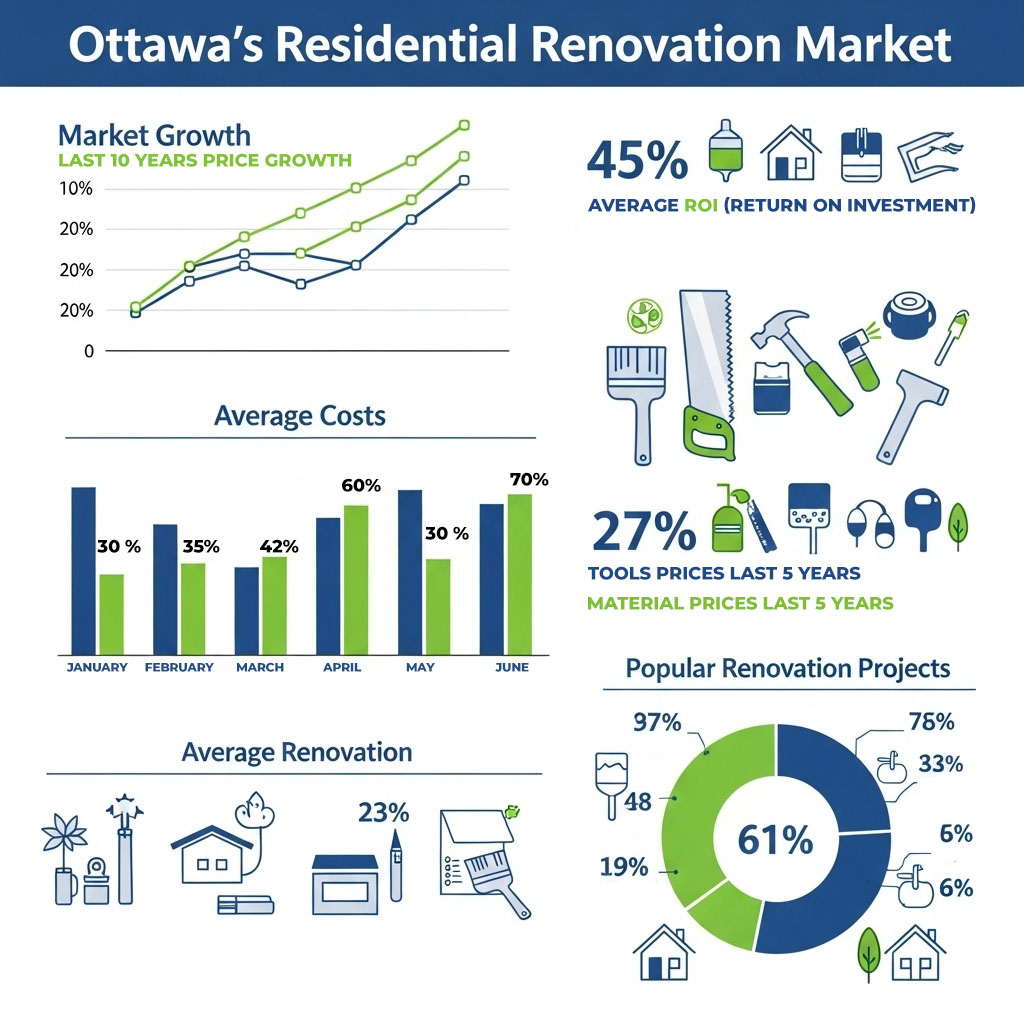Estimated reading time: 18 minutes
Table of contents
- Executive Summary: The Ottawa Renovation Market at a Glance
- 1. The Professional Landscape: Key Players, Associations, and Service Models
- 2. Macroeconomic and Market Dynamics
- 3. The Regulatory and Permitting Framework
- 4. Financial Resources for Homeowners and Professionals
- 5. The Consumer and Professional Dialogue
- 6. Strategic Outlook and Recommendations
Executive Summary: The Ottawa Renovation Market at a Glance
The Ottawa residential renovation industry is both stable and resilient. A balanced housing market, coupled with a strong, government-backed job base, actively drives this sector. Therefore, this report scrutinizes the main groups, economic factors, and rules that shape the industry.
Furthermore, strong professional groups actively support this market. Organizations such as the Greater Ottawa Home Builders’ Association (GOHBA) and the Canadian Home Builders’ Association (CHBA) promote professionalism through initiatives like the RenoMark program. Specifically, this program sets a high standard for conduct. Additionally, it builds consumer trust by requiring warranties, liability insurance, and detailed contracts.
The City of Ottawa has modernized its permitting process with a new online portal. Consequently, this change significantly streamlines the administrative burden for both homeowners and professionals. However, this digital transformation, along with local building codes and zoning bylaws, strongly emphasizes why professionals must know how to navigate these rules.
Financially, the market leverages both private and public funding. For instance, homeowners can utilize a Home Equity Line of Credit (HELOC). Moreover, they can access a multi-level system of government incentives. Programs like the federal Canada Greener Homes Initiative and the municipal Better Homes Ottawa – Loan Program offer substantial grants and low-interest loans. Ultimately, this creates a powerful market signal for specializations in energy efficiency and sustainability.
Finally, digital platforms have fundamentally reshaped how consumers and professionals interact. Online review sites and forums reveal that while technical skills are key, clients equally value transparency, communication, and project management. Thus, by understanding and proactively addressing these factors, a professional can succeed. Indeed, they can also build a reputation as a trusted partner.
1. The Professional Landscape: Key Players, Associations, and Service Models
1.1. Industry Associations as Market Gatekeepers
The Greater Ottawa Home Builders’ Association (GOHBA) formally represents the home construction and renovation industry within the Ottawa area. This group functions as a central hub for the industry. Its primary goal is to ensure good housing for Canadians. In fact, its membership is quite diverse. Specifically, members include builders, developers, renovators, trade contractors, suppliers, and manufacturers. Therefore, for professionals, GOHBA membership is a powerful sign of credibility.
Companies like Amsted Design-Build exemplify this prestige. The company won the Renovator of the Year award an industry-leading seven times. Furthermore, it also won the Green Renovation of the Year award for three consecutive years. Clearly, this recognition from a respected group proves a company’s work is good. Moreover, it gives them a clear edge over competitors.
It is important to know that GOHBA is different from the Ottawa Construction Association (OCA). Conversely, the OCA works only with the city’s non-residential construction industry. Therefore, for anyone working in home renovations, GOHBA is the best network for information, standards, and partnerships. GOHBA’s awards are more than just prizes. Rather, they are a real sign of excellence, which professionals can use as a powerful marketing tool.
1.2. The RenoMark Program: A Pillar of Professionalism and Consumer Trust
The Canadian Home Builders’ Association (CHBA) runs the RenoMark program, with assistance from GOHBA. This program is a key part of professionalism in the renovation industry. The CHBA created this program to help homeowners find renovators. Specifically, it helps them find professionals who are committed to quality and ethical business practices. Consequently, a contractor who agrees to the RenoMark Code of Conduct must meet a stringent set of requirements. This puts them above normal industry standards.
Key requirements include being a GOHBA member in good standing. In addition, they must also give a detailed written contract for all jobs. Furthermore, they must offer a minimum two-year warranty on all work, except minor repairs. Also, RenoMark contractors need at least $2 million in liability insurance. Finally, they must have all required licenses and permits, and stay up-to-date on building codes and rules through ongoing education.
These rules help with many of the main worries homeowners have when they hire a contractor. These worries include unclear contracts, not enough insurance, or a lack of responsibility after the job is done. Therefore, the program gives a clear sign of trust from a third party. This makes it easier for homeowners to check contractors, while also giving certified pros a big advantage.
1.3. Service Models: A Strategic Decision Between General Contractors and Design-Build Firms
People often call a general contractor the “maestro of the building orchestra.” This model works best for projects with a finished design. The homeowner hires one person to run the building part of the job. Furthermore, the general contractor manages the whole project from start to finish. This includes hiring and working with different subcontractors. Also, they manage budgets and keep the project on schedule. Typically, the homeowner acts as the go-between, connecting the independent designer and the general contractor.
A design-build firm is different. Instead, it offers a single, unified team that handles both design and construction under one roof. Companies like Amsted Design-Build, Peridot Design Build, and OakWood use this model. Consequently, they manage the entire process, from the first idea to the final project. This approach means the homeowner does not have to be the go-between. Ultimately, this makes the project smoother and easier. A big benefit is that they control the budget from the start. In other words, they check design and cost at the same time. This prevents homeowners from spending a lot on a design, only to find the cost is too high. Therefore, this model is good for clients who want convenience, a clear budget, and one person to talk to for the whole job.
The choice between these two models depends on the project’s complexity and the homeowner’s desired level of involvement. For example, for a major home addition or a whole-home renovation, the design-build model’s integrated approach can provide greater control and reduced stress. However, for smaller, more aesthetic-focused projects, a general contractor may be a more cost-effective option.
| Characteristic | General Contractor | Design-Build Firm |
| Scope of Work | Oversees construction, managing all aspects from start to finish. | Integrates design and construction under one company. |
| Project Management | Coordinates large teams of specialized subcontractors, ensuring the entire project runs smoothly. | Unified team of designers, project managers, and crew; homeowner is guided through decisions. |
| Role of Homeowner | Acts as the coordinator between the designer/architect and the contractor. | Works with a single, integrated team, eliminating the need to be the go-between. |
| Budget Control | Bids are based on finalized plans; budget issues may only emerge after design is complete. | Considers the budget from the outset, providing financial guardrails throughout the design phase. |
| Typical Projects | Home additions, large-scale structural changes, whole-home renovations. | Whole-home renovations, kitchen/bathroom remodels, and home additions. |
1.4. Key Service Providers and Suppliers: A Landscape Analysis
A strong network of businesses and professionals supports renovations in Ottawa. Online review platforms like the Better Business Bureau (BBB) and HomeStars list many local pros. As a result, many of them have great customer ratings. Customers have highly praised firms like Ottawa General Contractors and Granstone on HomeStars. They praise their professionalism, clear communication, and quality craftsmanship. These reviews clearly show that good communication and attention to detail are important; technical skill is not the only thing that matters.
Meanwhile, major suppliers of building materials also support the market. They serve both homes and businesses. Companies like Morin Supply and Distribution Matériaux Lavoie (DML) sell many products. In fact, they supply everything from gypsum board and metal ceilings to lumber and roof trusses. Therefore, these suppliers are a key part of the value chain. They make sure pros and homeowners can get the materials they need for any project. DML, in particular, stresses that their team is full of experts, including advisors, estimators, and technicians who give guidance throughout the building process.
2. Macroeconomic and Market Dynamics
2.1. The Broader Real Estate Context: An Analysis of the Ottawa Housing Market
Ottawa’s home renovation market is closely linked to the broader real estate market. Data from July 2025 shows Ottawa’s housing market is “balanced.” The sales-to-new listings ratio (SNLR) was 52%. Furthermore, a balanced market, with an SNLR between 40% and 60%, is a main reason for renovation work. In this market, neither sellers nor buyers have a big advantage. Consequently, homeowners often prefer to improve their current home for long-term value and enjoyment. This is easier than the uncertain process of buying or selling a new home.
The average home price in July 2025 was $695,209, a 2.3% increase year-over-year. While single-family home prices rose by 2.0% a year, townhouses did even better, seeing an 8.3% increase year-over-year. As home prices rise, homeowners have more equity. This gives them the money and confidence to pay for big renovations, which creates a positive cycle in the market. Ottawa has a strong job market driven by the government. This unique feature gives the city’s market stability, and it has historically protected it from the big swings seen in other Canadian cities.
| Metric | Value | 12-Month Change |
| Average Sold Price (All Property Types) | $695,209 | $+2.3\%$ |
| Average Sold Price (Single-Family) | $852,619 | $+3.3\%$ |
| Average Sold Price (Townhouse) | $560,919 | $+1.5\%$ |
| Average Sold Price (Apartment) | $430,836 | $-4.3\%$ |
| Total Transactions | 1,318 | $+6.2\%$ |
| Months of Inventory | 3.2 months | Not specified |
| Sales-to-New-Listings Ratio (SNLR) | 52% | $-7\%$ |
2.2. Cost Trends and Inflationary Pressures: The Residential Renovation Price Index (RRPI)
Statistics Canada created the Residential Renovation Price Index (RRPI). It measures how prices change each quarter. Specifically, it looks at prices that contractors charge for home renovation projects. The provided info does not have specific data for Ottawa. Nevertheless, the national trends are very useful for local professionals.
Across the country, renovation costs went up by 0.9% in the second quarter of 2025. A main reason for this was Canada’s new 25% import tax in March on materials like steel, aluminum, and iron. This link between large economic policy and local costs shows something important: The renovation industry is no longer separate from global and national trade decisions. Therefore, contractors who know about these changes must be smarter. They need to be more strategic with their pricing, how they get materials, and how they talk to clients. Consequently, they should be ready to talk to clients about changing prices. This is especially true for projects that use materials with new tariffs, such as new mechanical systems or solar installations. Essentially, this means they need to be proactive with risk management and project planning.
2.3. The Influence of Monetary Policy and Broader Economic Factors
Monetary policy plays a key role in Ottawa’s housing market. The Bank of Canada’s interest rate decisions are a big part of this. Clearly, mortgage rates affect how affordable homes are. Furthermore, they also affect if a buyer can get a loan. Recent rate cuts have helped homebuyers. However, mortgage rates are still much higher than they were during the pandemic. This situation makes it harder for some people to move. In turn, this then encourages them to invest in their current homes instead.
Ottawa’s job market is driven by the government. As a result, this makes the city’s market very stable. Other cities have markets that swing more. Conversely, Ottawa’s steady job base ensures constant housing demand. This leads to a steady flow of renovation projects. Ultimately, this creates a strong base for the renovation industry, making it a more predictable and less speculative market for professionals.
3. The Regulatory and Permitting Framework
3.1. Navigating Building Permits: The City of Ottawa’s Digital Process
Before you start a home renovation, you must check if you need a building permit. The City of Ottawa now has a new online portal on My ServiceOttawa. Through this portal, you can apply for permits without paper. This portal lets residents, builders, and pros submit applications and pay for them. Moreover, they can also upload documents and book inspections from a mobile device. This change makes the process faster and easier. Indeed, it used to take a lot of time. Now, pros can manage their projects more efficiently.
The City requires permits by law for any renovation. This includes projects with structural changes or new systems. For example, projects like finishing a basement need a permit. Similarly, building additions, removing load-bearing walls, or putting in new plumbing or electrical systems require one. If homeowners don’t get the right permits, they can face delays, fines, or having to tear down the work. Therefore, the City’s online portal makes it easier to follow the rules, as it gives a clear and central system for applying and tracking permits.
| Renovation Project | Permit Required? |
| Finishing a basement | Yes |
| Building additions or sunrooms | Yes |
| Removing load-bearing walls | Yes |
| Installing new plumbing or electrical systems | Yes |
| Creating a secondary dwelling unit | Yes |
| Replacing kitchen cabinets (if not modifying plumbing) | No |
| Painting, flooring, or cosmetic changes | No |
| Window or door replacement (if size and location remain the same) | No |
3.2. Understanding Zoning Bylaws and Their Impact on Renovation Scope
A project’s plan must also follow the City’s zoning rules. This is in addition to building permits. Ottawa has five main residential zones (R1 to R5). Consequently, each zone has its own rules for lot width, height, area, and setbacks. These rules decide what a property owner can build. Crucially, they can greatly affect the size and location of a home addition.
The City of Ottawa has a geoOttawa website. On it, homeowners and pros can find their specific zoning and understand the measurement rules. A project can meet the building code but still be denied. This often happens if it breaks a zoning rule, such as an addition that extends past a setback line. Therefore, a professional needs to understand both sets of rules. This ensures the project can be done from the very start.
3.3. Licensing and Certification: Verifying Professional Qualifications for Key Trades
For some trades, you must have a license or certificate. There is no way around it. The United Association (UA) Local 71 represents licensed plumbers, pipefitters, and welders. They work in the Ottawa-Gatineau-Cornwall area. Furthermore, this union trains its members all the time. This keeps them current with new technologies. Also, it ensures they follow national and provincial plumbing codes. If a project has plumbing, you should hire a licensed professional from a trusted group. This provides assurance of quality and safety.
Websites like the BBB also list many master electricians and electrical contractors in Ottawa. The existence of these resources enables homeowners to check a professional’s skills and ethics. This is very important for projects with new electrical systems or panel upgrades, which often support energy-efficient retrofits.
4. Financial Resources for Homeowners and Professionals
4.1. Government Incentives: A Multi-Tiered Approach to Funding
The Ottawa market connects renovation work with government policies. These policies focus on climate and housing. Therefore, homeowners can get money from a multi-level system of incentives. These incentives come from federal, provincial, and city governments.
- Better Homes Ottawa – Loan Program: This city program offers low-interest, 20-year loans up to $125,000. These loans cover home energy upgrades. The interest rate is a fixed $4.33\%$. Additionally, it offers $0\%$ interest loans for people who qualify based on income, and their administrative fees are also waived. The loan is tied to the property, not the person. Thus, this makes it a flexible choice for homeowners. The program covers projects like insulation, heat pumps, and renewable energy installations.
- Canada Greener Homes Initiative: This federal program gives grants from $\$125$ to $\$5,000$ for home retrofits. It also gives up to $\$600$ to pay for required energy evaluations. Furthermore, the program also has an interest-free loan of up to $\$40,000$ for major retrofits. The program covers projects that upgrade insulation in roofs, exterior walls, and foundations. It also covers air-sealing and replacing windows and doors.
- Ontario Renovates Program: For homeowners who meet certain income and property value rules, this program gives forgivable loans up to $\$25,000$. These loans cover key repairs and accessibility features. Eligible repairs include building exteriors, plumbing, and electrical systems. Moreover, it also covers things like ramps and handrails for accessibility.
These programs are very important. Specifically, they directly pay for projects that make a home better for energy and use. This creates demand for certain jobs. Therefore, this is a great chance for a professional to specialize in areas like energy-efficient retrofits, benefiting from the money incentives that make these projects more appealing to many homeowners.
| Program Name | Type of Funding | Maximum Amount | Interest Rate | Key Eligible Projects |
| Better Homes Ottawa | Loan ($20$-year term) | Lesser of $\$125,000$ or $10\%$ of home value | $4.33\%$ fixed ($0\%$ for income-qualified) | Energy retrofits, heat pumps, EV chargers, renewable energy |
| Canada Greener Homes | Grant & Interest-free loan ($10$-year term) | Up to $\$5,600$ (grant); Up to $\$40,000$ (loan) | $0\%$ for the loan | Home insulation, air-sealing, windows, doors |
| Ontario Renovates | Forgivable loan | Up to $\$25,000$ | Not specified | Essential repairs, accessibility modifications |
4.2. Private Financing: Utilizing Home Equity Lines of Credit (HELOCs) for Projects
A Home Equity Line of Credit (HELOC) is a flexible way to pay for projects. It is very good for renovations. A HELOC is a type of loan. Specifically, it uses your home’s equity as security. Equity is the difference between what your home is worth and what you still owe on your mortgage. Because your home is collateral, HELOCs often have lower interest rates. They are lower than credit cards or personal loans.
HELOCs give homeowners a lot of flexibility. They can use money up to a set limit as they need it. Crucially, they only pay interest on the money they use. Consequently, this makes it a perfect tool for big projects with many steps, where the costs are spread out over time. In Canada, you can often deduct the interest on a HELOC from your taxes. This is true if you use it for home improvements. To qualify, a homeowner must show proof of ownership and mortgage details. They may also need a home appraisal. This financial tool, plus government grants and loans, gives homeowners many options. They can pay for everything from small updates to big additions.
5. The Consumer and Professional Dialogue
5.1. Navigating Online Reputation: Insights from Review Platforms
Online reviews and directories have significantly changed how homeowners check contractors. This change is big. Websites like HomeStars and the BBB offer a clear view of a company’s work. They get this info from many people, which creates more accountability. Reviews for companies like Ottawa General Contractors show that customers are happy. Specifically, they like the service, which is timely, organized, and communicative.
Clients always praise pros for being professional. They like their attention to detail. Furthermore, they also like when a team respects their home and time. Reviews show that a good professional relationship needs more than just technical skill. Clients often talk about clear communication. They also mention a willingness to fix problems and a commitment to their vision. These things lead to good experiences. Therefore, having a good online reputation is just as important as professional credentials. A pro should work on this as a key part of their business plan.
5.2. A View from the Forum: Understanding Homeowner Pain Points and Questions
Online forums like TrustedPros show the real questions and worries of homeowners planning renovation projects. A common theme in these talks is that people don’t know enough. Homeowners often ask about project costs. They also ask if permits are needed. Furthermore, they want to know how to understand building codes for DIY jobs. Other questions are very technical. For instance, they ask about a tripping breaker or the pros and cons of different shower doors.
This data from many people shows a good chance for professionals. A pro can create content like blog posts or guides. This content can answer these common questions. In turn, this helps them become a trusted expert even before they get a job. Ultimately, this not only builds trust but also attracts clients who want a clear and smart partner. This changes the relationship from a simple deal to a partnership.
5.3. Local Events and Trade Shows: Networking and Sourcing Opportunities
Local trade shows are a key place for both pros and consumers to meet in person. The Ottawa Home & Garden Show and the Ottawa Home & Remodelling Show are big yearly events at the E.Y. Centre. Indeed, they bring hundreds of experts together. For homeowners, these shows are a one-stop shop. They can find ideas, meet experts, and get special deals on products and services.
For pros, these events are a great chance to network. They can find new clients and learn about the market. When businesses exhibit or attend these shows, they can meet many potential clients. Moreover, they can also keep up with the newest trends, materials, and tech. Overall, these shows are a valuable part of the Ottawa renovation scene, bringing everyone together for a fun and informative experience.
6. Strategic Outlook and Recommendations
6.1. Core Insights from the Ottawa Renovation Ecosystem
Our analysis of Ottawa’s renovation market shows some key ideas that go beyond the numbers. A stable, government-led economy makes the market strong. This provides constant demand no matter what the economy does. Furthermore, this stability and a balanced housing market encourage homeowners to invest in their homes for the long term.
The industry is becoming more professional. Programs like RenoMark are key for building consumer trust. They also set clear standards for quality and behavior. At the same time, rules are becoming more modern. The city’s digital portal makes the permit process easier. For a professional, this means they need technical skills, and they also need to be good with digital tools.
Government policy is a main driver of future demand. There are many money programs for energy-efficient upgrades. This sends a strong message to the market. Consequently, projects with insulation, heat pumps, and solar will likely keep growing. Finally, digital platforms have changed the relationship between clients and pros. Now, being open and communicating well is as important as good work.
6.2. Actionable Recommendations for a Prospective Industry Player
Based on these findings, here are some tips for a prospective industry player:
- Establish Credibility Through Certification: Get RenoMark certified. This is the most important way to show you are professional in a crowded market. Always promote this on all your platforms. It helps with client worries and gives you a competitive edge.
- Specialize in Energy-Efficient Retrofits: The market offers a lot of incentives for projects that improve home energy performance. Focus on things like insulation and heat pumps. This lets you tap into a demand that gets support from government loans and grants.
- Embrace Digital and Communication: Create blog posts or guides that answer common homeowner questions. This builds trust before you even give a quote. Also, make communication clear and quick. Online reviews show this makes a big difference.
- Plan for Macroeconomic Volatility: Have a good plan to manage risks. This plan should consider how things like import taxes affect material costs. Be ready to talk to clients about these risks. Furthermore, give them new cost estimates during the project to manage their expectations.
Key Takeaways
- The Ottawa renovation market is stable, driven by a solid job base and government support, emphasizing investment in home improvements.
- Organizations like GOHBA and CHBA promote high standards through initiatives such as the RenoMark program, enhancing consumer trust.
- Recent digital processes streamline permitting, making it easier for homeowners and professionals to navigate regulations.
- Government incentives like the Canada Greener Homes Initiative and Ontario Renovates Program provide funding for energy-efficient renovations.
- Understanding homeowner concerns and leveraging online platforms can build trust, making communication and transparency crucial for success.












